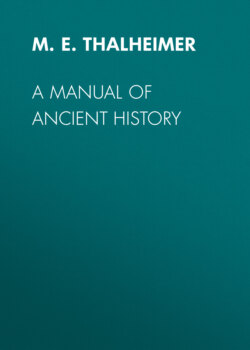Читать книгу A Manual of Ancient History - M. E. Thalheimer - Страница 21
PHŒNICIA.
Оглавление60. The small strip of land between Mount Lebanon and the sea was more important to the ancient world than its size would indicate. Here arose the first great commercial cities, and Phœnician vessels wove a web of peaceful intercourse between the nations of Asia, Africa, and Europe.
61. Sidon was probably the most ancient, and until BC 1050, the most flourishing, of all the Phœnician communities. About that year the Philistines of Askalon gained a victory over Sidon, and the exiled inhabitants took refuge in the rival city of Tyre. Henceforth the daughter surpassed the mother in wealth and power. When Herodotus visited Tyre, he found a temple of Hercules which claimed to be 2,300 years old. This would give Tyre an antiquity of 2,750 years BC
62. Other chief cities of Phœnicia were Bery´tus (Beirût), Byb´lus, Tri´polis, and Ara´dus. Each with its surrounding territory made an independent state. Occasionally in times of danger they formed themselves into a league, under the direction of the most powerful; but the name Phœnicia applies merely to territory, not to a single well organized state, nor even to a permanent confederacy. Each city was ruled by its king, but a strong priestly influence and a powerful aristocracy, either of birth or wealth, restrained the despotic inclinations of the monarch.
63. The commerce of the Phœnician cities had no rival in the earlier centuries of their prosperity. Their trading stations sprang up rapidly along the coasts and upon the islands of the Mediterranean; and even beyond the Pillars of Hercules, their city of Gades (Kadesh), the modern Cadiz, looked out upon the Atlantic. These remote colonies were only starting points from which voyages were made into still more distant regions. Merchantmen from Cadiz explored the western coasts of Africa and Europe. From the stations on the Red Sea, trading vessels were fitted out for India and Ceylon.
64. At a later period, the Greeks absorbed the commerce of the Euxine and the Ægean, while Carthage claimed her share in the Western Mediterranean and the Atlantic. By this time, however, Western Asia was more tranquil under the later Assyrian and Babylonian monarchs; and the wealth of Babylon attracted merchant trains from Tyre across the Syrian Desert by way of Tadmor. Other caravans moved northward, and exchanged the products of Phœnician industry for the horses, mules, slaves, and copper utensils of Armenia and Cappadocia. A friendly intercourse was always maintained with Jerusalem, and a land-traffic with the Red Sea, which was frequented by Phœnician fleets. Gold from Ophir, pearls and diamonds from Eastern India and Ceylon, silver from Spain, linen embroidery from Egypt, apes from Western Africa, tin from the British Isles, and amber from the Baltic, might be found in the cargoes of Tyrian vessels.
65. The Phœnicians in general were merchants, rather than manufacturers; but their bronzes and vessels in gold and silver, as well as other works in metal, had a high repute. They claimed the invention of glass, which they manufactured into many articles of use and ornament. But the most famous of their products was the “Tyrian purple,” which they obtained in minute drops from the two shell-fish, the buccinum and murex, and by means of which they gave a high value to their fabrics of wool.
66. About the time of Pygma´lion, the warlike expeditions of Shalmaneser II overpowered the Phœnician towns, and for more than two hundred years they remained tributary to the Assyrian Empire. Frequent but usually vain attempts were made, during the latter half of this period, to throw off the yoke. With the fall of Nineveh it is probable that Phœnicia became independent.
67. BC 608. It was soon reduced, however, by Necho of Egypt, who added all Syria to his dominions, and held Phœnicia dependent until he himself was conquered by Nebuchadnezzar (BC 605) at Carchemish. The captive cities were only transferred to a new master; but, in 598, Tyre revolted against the Babylonian, and sustained a siege of thirteen years. When at length she was compelled to submit, the conqueror found no plunder to reward the extreme severity of his labors, for the inhabitants had secretly removed their treasures to an island half a mile distant, where New Tyre soon excelled the splendor of the Old.
68. Phœnicia remained subject to Babylon until that power was overcome by the new empire of Cyrus the Great. The local government was carried on by native kings or judges, who paid tribute to the Babylonian king.
69. The religion of the Phœnicians was degraded by many cruel and uncleanly rites. Their chief divinities, Baal and Astar´te, or Ashtaroth, represented the sun and moon. Baal was worshiped in groves on high places, sometimes, like the Ammonian Moloch, with burnt-offerings of human beings; always with wild, fanatical rites, his votaries crying aloud and cutting themselves with knives. Melcarth, the Tyrian Hercules, was worshiped only at Tyre and her colonies. His symbol was an ever-burning fire, and he probably shared with Baal the character of a sun-god. The marine deities were of especial importance to these commercial cities. Chief of these were Posi´don, Ne´reus, and Pontus. Of lower rank, but not less constantly remembered, were the little Cabi´ri, whose images formed the figure-heads of Phœnician ships. The seat of their worship was at Berytus.
70. The Phœnicians were less idolatrous than the Egyptians, Greeks, or Romans; for their temples contained either no visible image of their deities, or only a rude symbol like the conical stone which was held to represent Astarte.
